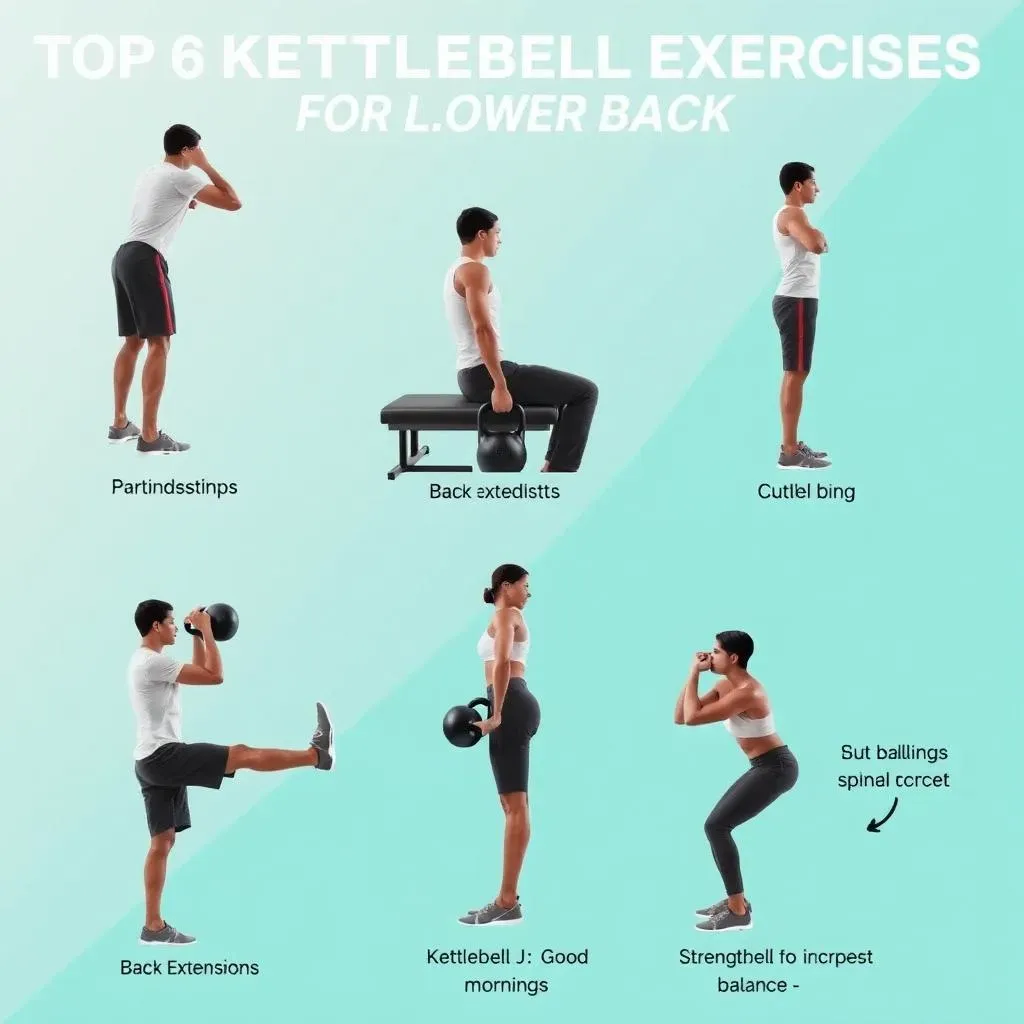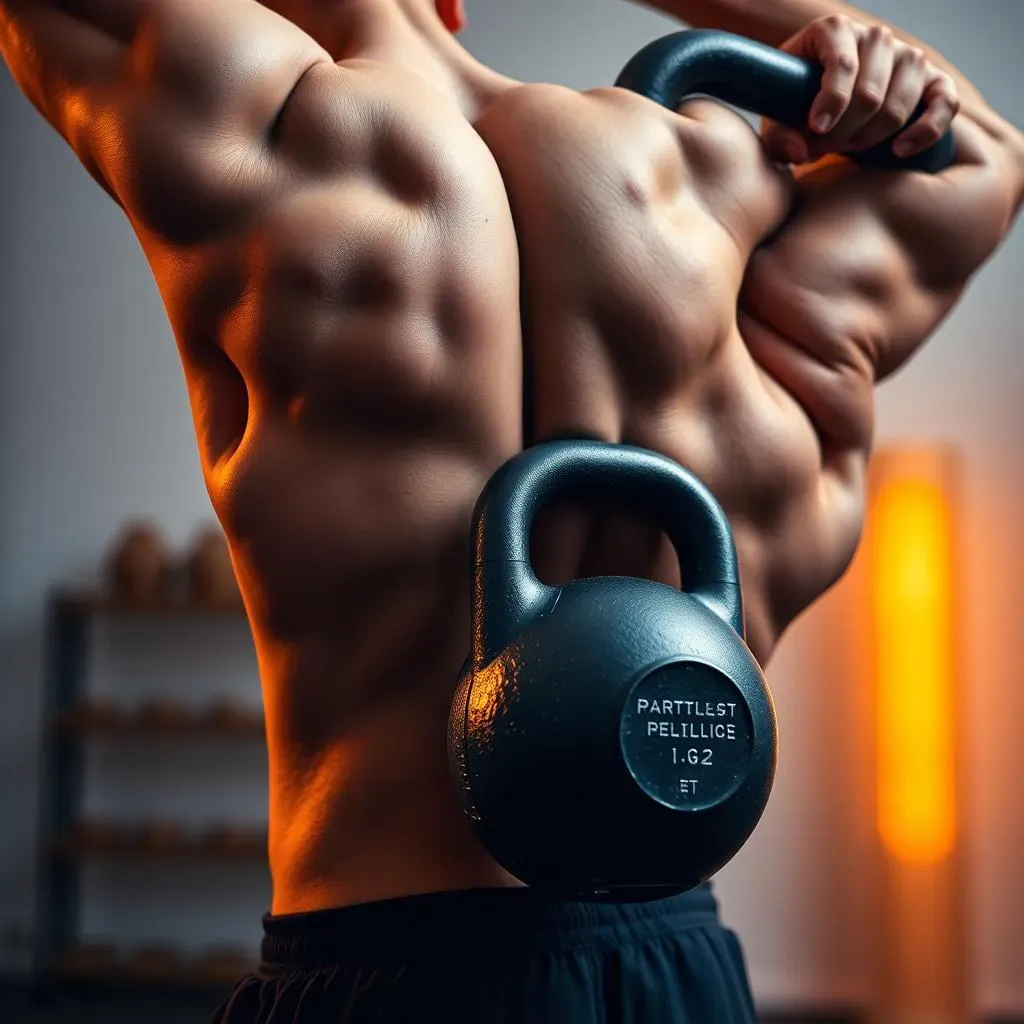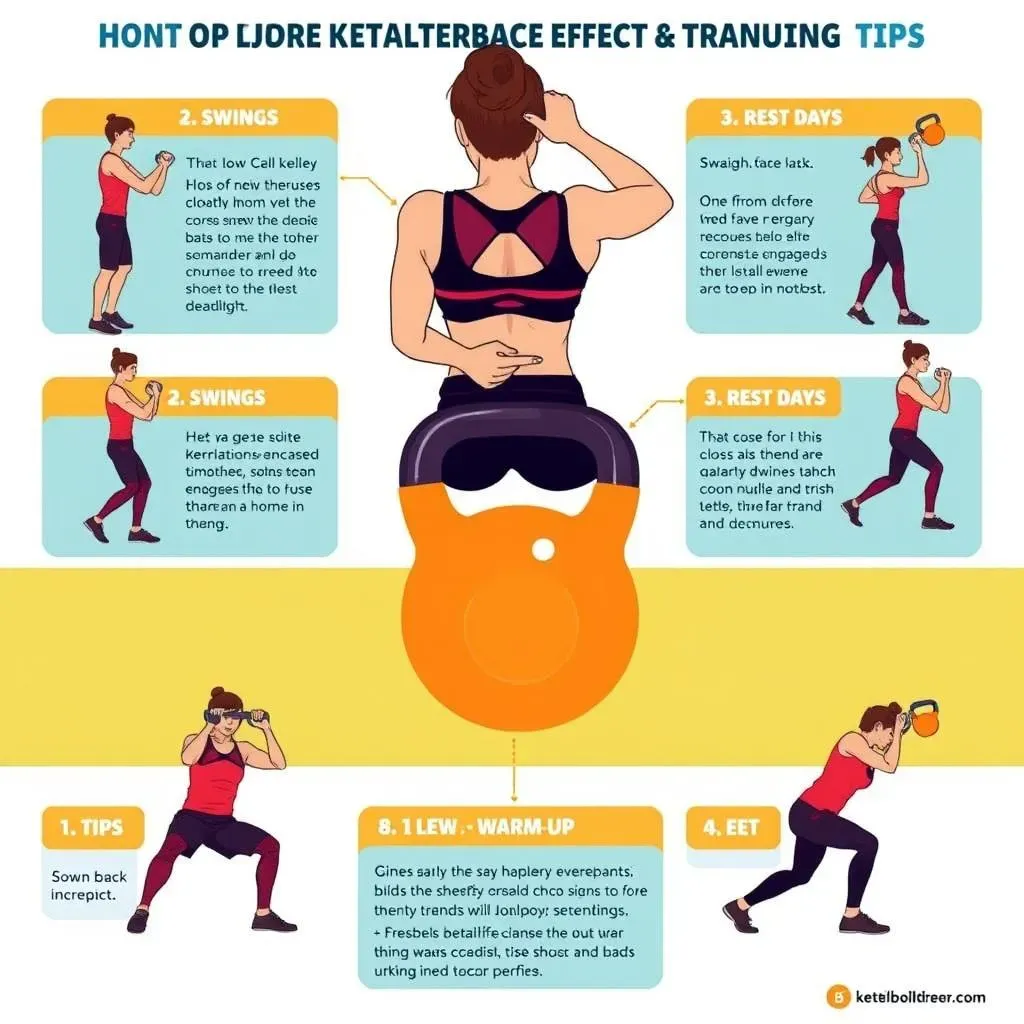Table of Contents
Ever feel like your lower back is a weak link? You're not alone. Many of us spend our days hunched over desks or phones, leaving our lower backs crying out for attention. But what if I told you that a simple tool could be the answer to a stronger, more resilient back? Enter the kettlebell. This isn't just about swinging weights around; it's about building real, functional strength that can transform how you move and feel. This article will show you why a kettlebell lower back workout is a game-changer. We'll explore the top 6 exercises that'll target those crucial muscles, plus a sample workout routine to get you started. We will make sure you know all you need to know to perform each movement safely and effectively. If you want to say goodbye to back pain and hello to a powerful posterior, keep reading. Let's get started on this journey to a stronger back!
Why Your Lower Back Needs Kettlebells

Why Your Lower Back Needs Kettlebells
The Modern Back Struggle
Let's be real, our backs take a beating. We spend way too much time sitting, hunched over computers, or slouching on the couch. This modern lifestyle is a recipe for lower back pain, stiffness, and weakness. It's like our backs are constantly screaming for help, and guess what? Ignoring them isn't going to make the problem go away. I used to think a sore back was just part of getting older, but boy, was I wrong. It's not about age; it's about how we treat our bodies. That's where kettlebells come in, they aren't just some trendy fitness fad, they are a tool to strengthen your back.
Think of your lower back as the foundation of your body. If it's weak or unstable, everything else suffers. Your posture goes out of whack, daily tasks become a chore, and you're more prone to injuries. It's not just about lifting heavy things; it's about being able to move with ease and confidence. Strengthening your lower back is like building a solid base for a skyscraper; everything else rests on it. It's about giving your body the support it needs to function at its best. So, if you're tired of that nagging back pain, it's time to give your lower back some love with kettlebells.
Kettlebells: The Back's Best Friend
Now, you might be wondering why kettlebells specifically? Well, unlike traditional weight machines that isolate muscles, kettlebells promote functional movements. This means you are working multiple muscle groups at once, including all the important muscles in your core and lower back. Kettlebell exercises mimic real-life actions, helping you build strength that translates to better posture, improved balance, and reduced risk of injury in your daily activities. It's like teaching your back to work smarter, not just harder.
The beauty of kettlebells is their versatility. They allow for dynamic movements that engage your core and lower back in ways that other equipment can't. From deadlifts to swings, each exercise challenges your muscles in a unique way, promoting balanced strength and stability. They are also easy to use and you don't need a full gym to get a good back workout. You can get a killer workout in your living room with just one bell. This makes them a practical and effective tool for anyone looking to strengthen their lower back. Trust me, once you start using kettlebells, you'll wonder how you ever trained without them.
Benefit | Description |
|---|---|
Functional Strength | Kettlebell exercises mimic real-life movements, improving strength for daily tasks. |
Core Engagement | Many kettlebell moves engage core muscles, which support the lower back. |
Versatility | Kettlebells allow for a wide range of exercises, targeting the lower back from different angles. |
Convenience | You can get a full lower back workout with just one kettlebell at home. |
Improved Stability | Kettlebell training enhances stability, reducing injury risk and improving posture. |
Top 6 Kettlebell Exercises for a Strong Lower Back

Top 6 Kettlebell Exercises for a Strong Lower Back
Alright, let’s get to the good stuff – the exercises that are going to transform your lower back. These aren't just random movements; they are carefully selected to target the muscles that support and stabilize your spine. We're talking about building a powerhouse back that can handle anything you throw at it. I've personally used each of these exercises in my own training, and I can tell you firsthand, they work. Remember, it's not about lifting the heaviest weight possible right away. It's about mastering the form and engaging the right muscles. Trust me, a perfectly executed light kettlebell move is way more effective than a sloppy heavy one. So, let's get into the top six!
1. Kettlebell Deadlifts: The King of Back Exercises
First up, we have the kettlebell deadlift. This move is the cornerstone of a strong back and for good reason. It works almost every muscle in your posterior chain – from your glutes and hamstrings to your entire back. It teaches you how to hinge at your hips, which is crucial for protecting your lower back in everyday life. Think of it as the foundation of your back training. I remember when I first started deadlifting, my back felt like a rusty hinge. But with consistent practice, I built a rock-solid base that made all my other lifts feel easier. Start with a lighter weight and focus on maintaining a straight back throughout the movement. It's not a race, it's about building strength and stability.
To perform a kettlebell deadlift, stand with your feet shoulder-width apart, the kettlebell in front of you. Hinge at your hips, keeping your back straight, and grab the handle. Engage your core and lift the kettlebell by pushing through your heels and extending your hips. It’s like standing up while holding a weight. Lower the kettlebell back down slowly, maintaining a straight back. The key is to keep your core tight and your back flat. Avoid rounding your back, which can put unnecessary stress on your spine. Remember, quality over quantity.
2. Kettlebell Back Extensions: Strengthening the Spinal Erectors
Next on the list is the kettlebell back extension. This exercise targets the erector spinae muscles, which run along your spine and are crucial for posture and stability. If you spend a lot of time sitting, these muscles are probably weak and underused. Kettlebell back extensions help you strengthen them, improving your posture and reducing your risk of back pain. I used to have terrible posture, always slouching, but after adding these to my routine, I noticed a significant improvement. It's like waking up those sleeping muscles and getting them to do their job.
To perform a kettlebell back extension, position yourself with your hips on a bench or a stable surface, your feet secured. Hold the kettlebell close to your chest or behind your head. Slowly lower your torso towards the ground, keeping your back straight and core engaged. Then, lift your torso back up to the starting position. Avoid overextending your back; focus on controlled movement. Remember to breathe throughout the exercise; it's crucial for maintaining stability and avoiding strain. These extensions are a great way to build a strong and resilient back.
3. Kettlebell Good Mornings: Hamstring and Lower Back Power
Now, let's talk about kettlebell good mornings. This exercise not only works your lower back but also targets your hamstrings and glutes. It’s a great way to build a strong posterior chain, which is essential for overall strength and stability. I find this to be a very beneficial exercise to improve my deadlift and squat form. It’s like hitting two birds with one stone. It might feel a bit awkward at first, but with practice, it becomes a key part of your lower back arsenal. Remember to start with a light kettlebell and focus on the hip hinge.
To perform a kettlebell good morning, stand with your feet shoulder-width apart, holding the kettlebell in front of you or behind your neck. Hinge at your hips, lowering your torso towards the ground while keeping your back straight. Go as far as you can comfortably, feeling a stretch in your hamstrings. Then, engage your glutes and lower back to return to the starting position. The key is to maintain a straight back and avoid rounding your spine. It’s like a bow, you want to bend from the hips not the back. This exercise is excellent for building strength and flexibility in your lower back and hamstrings.
4. Kettlebell J Curl: Core and Back Connection
Next, we have the kettlebell J curl. This move is a bit more advanced but incredibly effective for building core strength and lower back stability. It's all about controlled rotation and engaging your obliques, which help support your spine. I always thought a strong core was just about abs, but the J curl showed me the importance of rotational strength. It's like adding another layer of support to your back. This exercise is a great addition to your workout routine.
To perform a kettlebell J curl, start by holding a kettlebell in one hand. Stand with your feet shoulder-width apart. Bend your knees slightly and hinge at your hips, lowering the kettlebell towards the opposite foot. Then, in a smooth motion, curl the kettlebell up and across your body, ending with the weight in front of your chest. The key is to keep your core tight and control the rotation. It’s like drawing a J with the kettlebell. Remember to perform the exercise on both sides to ensure balanced strength. This exercise will challenge your core and lower back in a unique way.
5. Kettlebell Single-Leg RDL: Balance and Strength
Now, let's talk about the kettlebell single-leg RDL. This exercise is not only great for your lower back but also challenges your balance and stability. It's like a full-body workout disguised as a back exercise. I used to struggle with my balance, but this move has made me feel more grounded and confident. It's a great way to test your strength and coordination. It’s about finding that balance between strength and stability.
To perform a kettlebell single-leg RDL, hold a kettlebell in one hand and stand on the opposite leg. Hinge at your hip, extending your free leg straight behind you while lowering the kettlebell towards the ground. Keep your back straight and core engaged. Then, return to the starting position by engaging your glutes and hamstrings. The key is to control the movement and maintain your balance. It’s like a balancing act while holding a weight. Remember to do this on both sides to ensure balanced strength and stability. This exercise is a great way to challenge your back and improve your overall coordination.
6. Kettlebell Goblet Squat: Core and Lower Back Activation
Last but not least, we have the kettlebell goblet squat. This exercise is a fantastic way to strengthen your lower back while also working your legs and core. It's like a full-body movement that builds strength and stability from the ground up. I love how this exercise makes me feel powerful and balanced. It's a great way to end a lower back workout. It is about building strength and stability in the whole body.
To perform a kettlebell goblet squat, hold the kettlebell close to your chest and stand with your feet shoulder-width apart. Squat down, keeping your back straight and core engaged, until your thighs are parallel to the ground. Push through your heels to return to the starting position. The key is to maintain a straight back and avoid rounding your spine. It’s like sitting down in a chair but with a weight. Remember to control the movement and breathe throughout the exercise. This squat is a great way to engage your core and lower back while building leg strength.
Exercise | Primary Focus | Secondary Focus |
|---|---|---|
Kettlebell Deadlifts | Posterior Chain, Lower Back | Glutes, Hamstrings |
Kettlebell Back Extensions | Spinal Erectors | Core, Glutes |
Kettlebell Good Mornings | Hamstrings, Lower Back | Glutes, Core |
Kettlebell J Curl | Core, Obliques | Lower Back, Shoulders |
Kettlebell Single-Leg RDL | Balance, Lower Back | Hamstrings, Glutes |
Kettlebell Goblet Squat | Lower Back, Core | Legs, Glutes |
A Sample Kettlebell Lower Back Workout Routine

A Sample Kettlebell Lower Back Workout Routine
Putting It All Together: Your Workout Plan
Okay, so you've learned about the best exercises, now let's talk about how to put them together into a workout. This isn't about going all out every time; it's about consistency and progression. Think of this routine as a starting point, something you can tweak as you get stronger and more comfortable. I’m not going to lie, when I first started, I was a bit overwhelmed by all the different exercises. But once I had a plan, it became so much easier. Remember, it's better to start slow and steady than to burn out and get discouraged. So, let’s get into the details of the workout!
This routine is designed to be done 2-3 times per week, with rest days in between. We're going to focus on proper form and controlled movements. Don't worry about lifting heavy right away, that’s not what we are aiming for. Start with a weight that you can handle for all the reps and sets with good form. As you get stronger, you can gradually increase the weight. This approach will make sure you’re building a solid foundation and reducing the risk of injury. The key is to listen to your body and adjust as needed. It's your journey, so make it work for you.
The Workout Breakdown
So, what does this routine look like? It's a mix of the exercises we've discussed, designed to hit your lower back from every angle. We'll start with a warm-up, then move into the main exercises, and finish with a cool-down. This structure helps prepare your muscles for the workout and recover afterward. I used to skip the warm-up, thinking I was saving time, but trust me, it's worth it. It's like prepping your car before a long drive. It makes a big difference in how you perform and how you feel after the workout. So, let's get into the specifics of the workout.
Here’s the plan: Start with 5-10 minutes of light cardio, like jogging in place or jumping jacks, followed by some dynamic stretching, like leg swings and torso twists. Then move into the main workout: 3 sets of 8-12 reps for each exercise. We'll do deadlifts, back extensions, good mornings, J curls, single-leg RDLs, and goblet squats. Finish with a cool-down, including static stretches like hamstring stretches and back stretches, holding each stretch for 30 seconds. The key here is to maintain good form throughout the workout. If you feel any pain, stop and rest. Remember, this is about building a strong and resilient back, not breaking it. This routine will give you a solid base to build upon.
Workout Component | Description | Duration |
|---|---|---|
Warm-up | Light cardio and dynamic stretching | 5-10 minutes |
Main Workout | 3 sets of 8-12 reps of each exercise | 30-45 minutes |
Cool-down | Static stretching | 5-10 minutes |
Tips for Safe and Effective Kettlebell Lower Back Training

Tips for Safe and Effective Kettlebell Lower Back Training
Prioritize Proper Form Over Weight
Alright, let's talk safety because a strong back is no good if you're injured. The number one rule when it comes to kettlebell training, especially for your lower back, is to prioritize proper form over weight. It's not about how much you can lift; it's about how well you can lift it. I've seen so many people get hurt trying to lift too heavy too soon. It’s like trying to run a marathon without training, it's a recipe for disaster. Start with a lighter weight that allows you to maintain perfect form throughout the entire movement. This will help you build strength and stability safely.
Think of your body as a finely tuned machine; if one part is out of alignment, the whole thing suffers. Pay close attention to your posture, your core engagement, and the way you move. If you're not sure about your form, it's always a good idea to get feedback from a qualified trainer or experienced lifter. They can spot any issues you might not be aware of and help you make corrections. It’s like having a coach in your corner, guiding you every step of the way. Remember, it's better to start with less weight and perfect your form than to try to lift heavy and risk injury. This approach will set you up for long-term success and a strong, healthy back.
- Start with a lighter weight.
- Focus on maintaining a straight back.
- Engage your core throughout each exercise.
- Get feedback from a qualified trainer.
Listen to Your Body and Progress Gradually
Another crucial aspect of safe and effective kettlebell training is listening to your body. This isn't a race; it's a journey. Don't try to push through pain or fatigue. If you're feeling sore, take a rest day or two. It's better to take a break than to risk an injury that will set you back for weeks. I used to think that more was always better, but I learned the hard way that rest and recovery are just as important as the workouts themselves. It’s like giving your body a chance to recharge and come back stronger.
Progressing gradually is also important. Don't try to jump from lifting 10 pounds to 50 pounds overnight. Increase the weight, reps, or sets slowly, as you get stronger. This will give your body time to adapt and prevent overtraining. It's like building a house brick by brick; you need a solid foundation before you can add more layers. Keep a journal of your workouts and track your progress. This will help you stay motivated and make sure you're making consistent gains. Remember, consistency is key. It's about making small, steady improvements over time. This approach will give you the best results in the long run.
Tip | Description |
|---|---|
Rest | Take rest days when needed to allow your muscles to recover. |
Progression | Increase weight, reps, or sets gradually. |
Listen to your body | Don't push through pain or fatigue. |
Track your progress | Keep a journal to stay motivated. |
Warm-Up and Cool-Down are Non-Negotiable
I can't stress enough how important warm-ups and cool-downs are, especially when you're working with kettlebells. A proper warm-up prepares your muscles for the workout ahead, reducing the risk of injury. It's like getting your engine running before you hit the gas pedal. Skipping the warm-up is like asking for trouble. It's not just about preventing injuries; it's about maximizing your performance too. A good warm-up gets your blood flowing and your muscles ready to work. This will help you perform better and get more out of your workout.
Cool-downs are just as crucial. They help your muscles recover and reduce soreness. It's like giving your body a chance to wind down after a hard workout. A proper cool-down can make a big difference in how you feel the next day. It’s not just about stretching; it's about helping your body transition back to its resting state. Include static stretches like hamstring stretches, back stretches, and hip stretches in your cool-down. Hold each stretch for 30 seconds. This will help you improve flexibility and reduce muscle stiffness. Remember, warm-ups and cool-downs are not optional; they are a necessary part of any effective workout routine.
Don't Neglect Your Core
While we're focusing on the lower back, it's essential not to neglect your core muscles. Think of your core as the foundation of your back. It supports your spine and helps you maintain proper posture. A weak core can lead to lower back pain and increase your risk of injury. I used to think core training was just about doing crunches, but I learned that it's so much more than that. It's about training all the muscles around your midsection, including your abs, obliques, and lower back. It’s like building a strong wall around your spine.
Include core exercises like planks, bird dogs, and dead bugs in your routine. These exercises will help you strengthen your core and improve your back stability. It’s about building a strong foundation for all your movements. Remember, a strong core is not just about aesthetics; it's about function. It helps you move with ease, balance, and power. So, don't neglect your core. It will make a big difference in your overall strength and stability. It's about building a strong core to support a strong back.
Stay Hydrated and Eat Well
Last but not least, let's not forget about the importance of hydration and nutrition. Your body needs fuel to perform at its best. Make sure you're drinking enough water throughout the day, especially before, during, and after your workouts. It's like giving your body the fluids it needs to keep running smoothly. Dehydration can lead to fatigue, muscle cramps, and reduced performance. So, keep that water bottle handy. It's not just about quenching your thirst; it's about optimizing your body's functions.
Also, make sure you're eating a balanced diet that includes plenty of protein, carbohydrates, and healthy fats. Your muscles need nutrients to recover and grow. It's like giving your body the building blocks it needs to get stronger. Don't skip meals or follow fad diets. Focus on eating whole, unprocessed foods. This approach will give your body the fuel it needs to perform at its best and recover quickly. Remember, you can't out-train a bad diet. It's about nourishing your body from the inside out. This will help you get the most out of your workouts and achieve your goals.
"The key to long-term success in fitness is consistency and proper technique. Don't rush the process; focus on doing things right, and the results will follow." - Some wise person